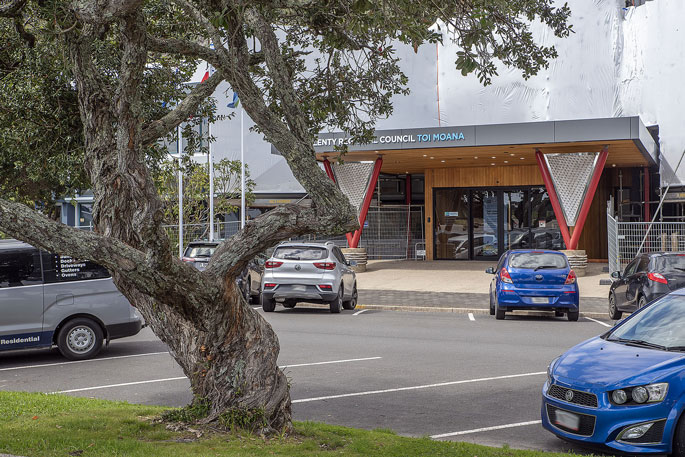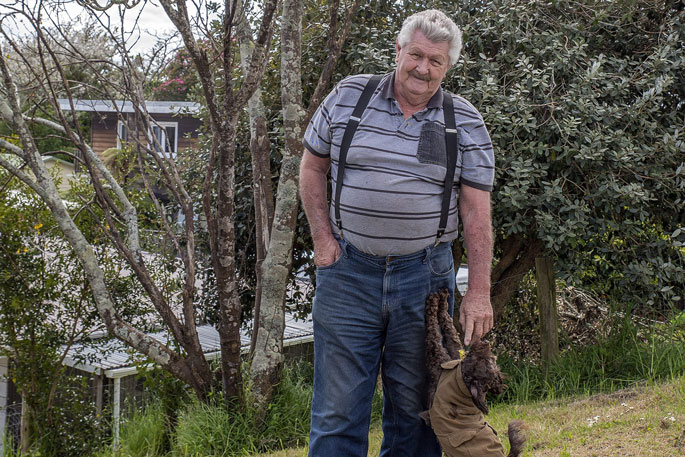Whakatāne's Don Meads is heartbroken the kowhai tree he scattered his wife’s ashes under on the riverbank behind his house in Riverside Drive is to be torn out.
Bay of Plenty Regional Council says the removal of the tree is essential if the stopbank is to protect Whakatāne from flooding.
Mr Meads, now aged 77, and his late wife, Maryanne, bought their home, which backs on to the stopbank of the Whakatāne River, over 10 years ago. He was told by the real estate agent at the time that the use of the stopbank came as part of the property and they were responsible for its upkeep.
Mrs Meads died in 2018 after a struggle with Alzheimer’s, which saw Mr Meads caring for her at home for three years before having to relinquish her to residential care. He said they had loved to sit on the bank, eating the fruit from their citrus trees growing on the stopbank and watching the tui in the kowhai tree.
After her death, Mr Meads scattered her ashes around the tree in memory of the happy hours they had spent there.
Now, Bay of Plenty Regional Council says it needs to go. As part of the Safeguarding Our Stopbanks programme of work, to strengthen stopbanks along the Whakatāne River, the regional council is removing vegetation and structures that create weaknesses in the stopbank structure.
It is a four-stage project. Stages one and two, which removed trees from the Whakatane Bridge to just past Ferry Road is mostly completed. Over this summer the council will be tackling stage three, the part of Riverside Drive closest to Awatapu Drive.
Mr Mead’s kowhai tree, along with others on the stopbank behind his house, will need to be dug out by the roots. He wants the regional council to “cease and desist with trying to make a mess” of his property.
He said the council was refusing to acknowledge the agreement that was made in the mid-1970s between the Rangitaiki Drainage Board and the residents of Riverside Drive when the stopbank was raised.
“Because there wasn’t enough room for the stopbank to be built further away from the properties, there was an agreement made between the residents to use some of their property for the toe of the stopbank and the residents would be gifted the use of the stopbank as their own property, provided they maintained it.”
Mr Meads said he had no documentation to prove this agreement existed.
“Don’t be silly. This was 1977 when people were honest and they shook hands and made a deal,” he said.
He believes that any documentation belonging to the drainage board was long ago thrown away by the regional council.
“It was taken up to the Burma Road tip. Truckloads of it. I know, because I saw it at the time.”
A staff spokesperson for the regional council said it had engaged an independent survey of Mr Meads property to confirm boundary lines and the stopbank was on public land.
It had also conducted an ecological assessment of the tree concerned, which had been found to be in poor health with some dead limbs, making it unlikely to survive relocation.
“The tree’s condition underscores the importance of its removal from the stopbank to ensure its ongoing integrity,” the spokesperson said.
The council had also offered to engage an independent arborist to further assess the tree and provide more technical advice, however, this was subject to acceptance and co-operation by the property owner.
“Regional Council has made every effort to work with and address the concerns raised by the owner of the property on Riverside Drive regarding this work,” the spokesperson said.
Eastern Bay regional councillor Malcolm Campbell said he was aware Mr Meads didn’t feel that he had been fairly treated.
“To a certain extent he’s possibly right. I have a lot of empathy for him, and for a lot of those other people around Riverside Drive but there is a job to do. It’s not a nice time for them, but it’s a necessary time.
“The worst part of all of this is that there is a whole lot of history gone on here - a lot of okays given by regional council staff and building permits issued by Whakatāne District Council, but now all that stuff has gone electronic and all of that proof has gone. A lot of it, also, has been just a handshake and ‘yeah-nah, just go ahead’.
“In fairness to all those people along there, they’ve tended and lovingly cared for the stopbanks. They’re not happy with the way they’ve been treated. At the same time, we are tasked with making sure that the town of Whakatāne is kept safe. We might be in a whole different situation had (Cyclone) Gabrielle crashed into the Eastern Bay.
Mr Meads thinks the stopbank issue could be solved using sheet piling on the river side of the bank. Sheet piling is being used on some parts of Project Future Proof, the regional council’s flood protection programme of work for the Whakatāne town centre.
 A row of pohutukawa line the banks of the Whakatane River outside the Bay of Plenty Regional Council office in Quay Street.
A row of pohutukawa line the banks of the Whakatane River outside the Bay of Plenty Regional Council office in Quay Street.
Mr Campbell agreed that might work but would be “prohibitively expensive”.
“Sheet piling would be the answer but boy of boy, who’s going to pay. It’s all very well to say regional council will pay, we’re talking about millions and millions of dollars and we don’t want to be putting everyone’s rates up because of that,” he said.
Mr Meads also pointed out that the pohutukawa trees growing along the floodwall outside the regional council offices in Quay Street, where there was seepage during a heavy rain event in 2017, were causing a flood risk.
“The regional council, across the road from their office, have several pohutukawa trees growing underneath the flood wall which are 10 times worse that my one kowhai tree on the stopbank that doesn’t leak,” he said.
This part of the riverbank is planned to be remediated as part of the regional council’s Project Futureproof, which is another four-stage project to strengthen flood defences around the central business district of Whakatāne.
The Quay Street area is part of a later stage of the project and the regional council said consideration of the trees was part of the ongoing design work related to Project Future Proof and no decision had been made at this time.
Public Interest Journalism funded through NZ On Air.




0 comments
Leave a Comment
You must be logged in to make a comment.